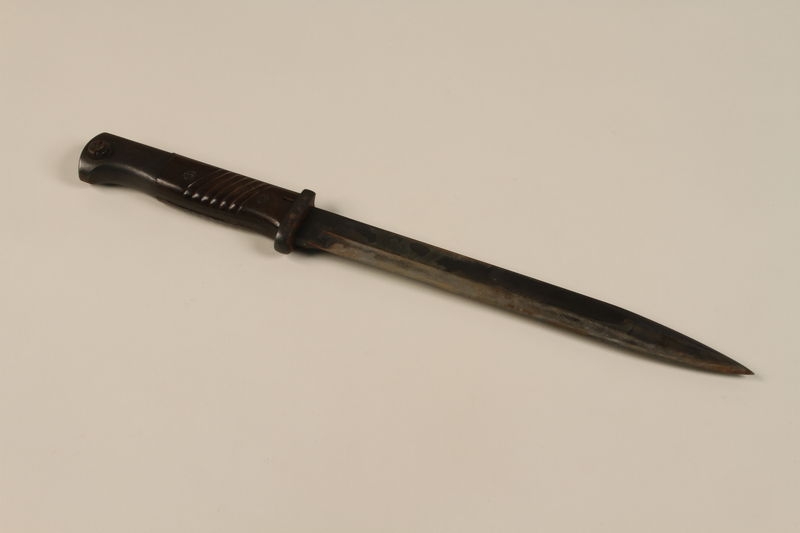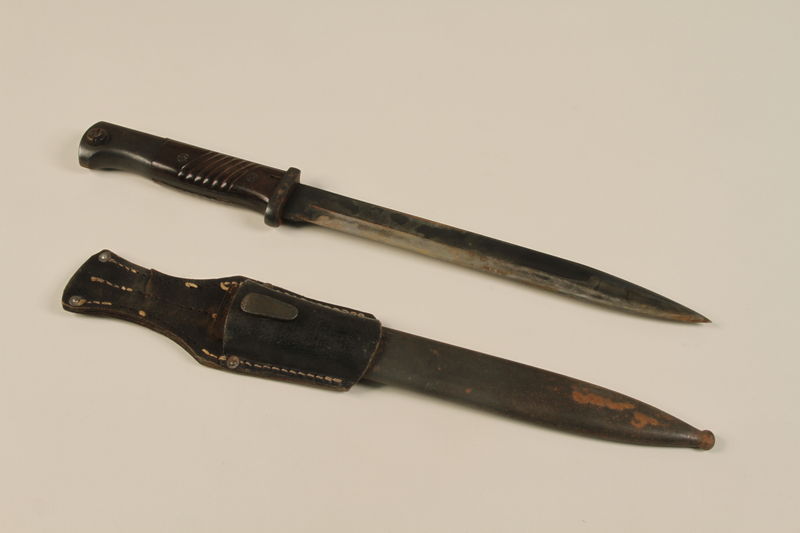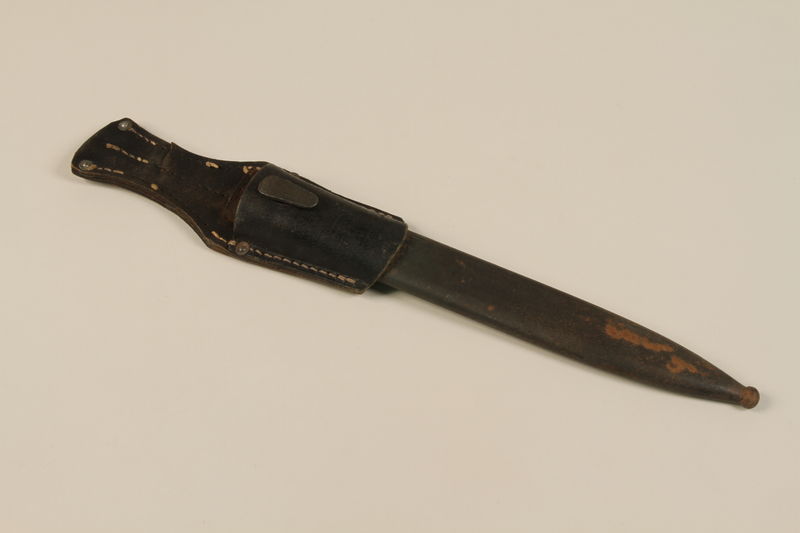Overview
- Brief Narrative
- Fighting knife and sheath, possibly a Mauser bayonet, retrieved by Robert Alden, an American soldier, from German soldiers as he helped to liberate concentration camps in Germany in April-May 1945. The 22 year old Alden was a captain in the Corps of Engineers in the Third Army under General Patton. Divisions of the Third Army liberated several concentration camp, including Dora-Mittelbau, Buchenwald, Dachau and several subcamps. When the war in Europe ended on May 7, 1945, Alden went to the Philippines and was stationed in Japan during the US military occupation.
- Date
-
received:
approximately 1945 April-1945 May
- Geography
-
received:
Germany
- Credit Line
- United States Holocaust Memorial Museum Collection, Gift of Dion Alden Holt
- Contributor
-
Subject:
Robert Alden
- Biography
-
Robert Alden was born on August 4, 1922, in Huntington on Long Island in New York. His father was a physician and his mother was a teacher. He attended City College from 1938-1942, then obtained a job as a messenger boy in the advertising department of the New York Times. He entered the United States Army on October 31, 1942. He earned the rank of captain as a platoon leader in the Corps of Engineers, Third Army, under General George S. Patton. He saw action in Europe during the Battle of the Bulge and during the continued advance through France, Germany, and Austria. Divisions of the Third Army liberated several concentration camp, including Dora-Mittelbau, Buchenwald and Dachau and several subcamps. When the war in Europe ended on May 7, 1945, Alden went to the Philippines and was stationed in Japan during the US military occupation. After his return stateside, he resumed his position as a copy editor and make-up man at the New York Times, and then became a local reporter. In 1969, Alden married Dion Imerman, with whom raised three stepdaughters. He held a number of different positions with the Times, including a stint as a war correspondent during the Korean War. In 1972, Alden became the United Nations bureau chief. He died, age 51, of a heart attack in 1973 in New York.
Physical Details
- Language
- German
- Classification
-
Weapons
- Category
-
Daggers and swords (edged weapons)
- Object Type
-
Daggers (lcsh)
- Physical Description
- a. Knife with wood on the middle of the handle and a jagged blade: 15-1/4" (38.7 cm) [unsheathed knife]; 16" (40.6 cm) [knife in sheath]
b. Black sheath.
c. Black leather holster. - Dimensions
- overall: Height: 16.000 inches (40.64 cm) | Width: 2.500 inches (6.35 cm) | Depth: 1.375 inches (3.493 cm)
- Materials
- overall : metal, leather, wood, plastic
Rights & Restrictions
- Conditions on Access
- No restrictions on access
- Conditions on Use
- No restrictions on use
Keywords & Subjects
Administrative Notes
- Legal Status
- Permanent Collection
- Provenance
- The knife was donated to the United States Holocaust Memorial Museum in 1989 by Dion Alden Holt, the widow of Robert Alden.
- Funding Note
- The cataloging of this artifact has been supported by a grant from the Conference on Jewish Material Claims Against Germany.
- Record last modified:
- 2023-06-06 13:19:01
- This page:
- https://collections.ushmm.org/search/catalog/irn823
Also in Robert Alden collection
The collection consists of artifacts relating to the experiences of Robert Alden as a soldier in the United States Army during World War II when he participated in the liberation of concentration camps in Germany.
Date: 1945
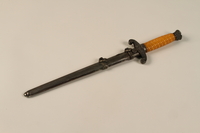
Yellow handled dagger with an engraved Reichsadler with sheath acquired by a US soldier
Object
Engraved knife and sheath retrieved by Robert Alden, an American soldier, from German soldiers as he helped to liberate concentration camps in Germany in April-May 1945. The 22 year old Alden was a captain in the Corps of Engineers in the Third Army under General Patton. Divisions of the Third Army liberated several concentration camp, including Dora-Mittelbau, Buchenwald, Dachau and several subcamps. When the war in Europe ended on May 7, 1945, Alden went to the Philippines and was stationed in Japan during the US military occupation.
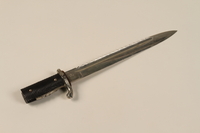
Dagger with a serrated edge and sheath acquired by a US soldier from German troops
Object
Serrated fighting knife and sheath retrieved by Robert Alden, an American soldier, from German soldiers as he helped to liberate concentration camps in Germany in April-May 1945. The 22 year old Alden was a captain in the Corps of Engineers in the Third Army under General Patton. Divisions of the Third Army liberated several concentration camp, including Dora-Mittelbau, Buchenwald, Dachau and several subcamps. When the war in Europe ended on May 7, 1945, Alden went to the Philippines and was stationed in Japan during the US military occupation.
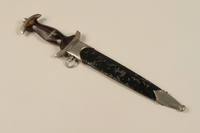
Wooden handled dagger with an embossed SA emblem and sheath acquired by a US soldier from German troops
Object
SA embossed dagger with an etched wooden handle and sheath retrieved by Robert Alden, an American soldier, from German soldiers as he helped to liberate concentration camps in Germany in April-May 1945. The 22 year old Alden was a captain in the Corps of Engineers in the Third Army under General Patton. Divisions of the Third Army liberated several concentration camp, including Dora-Mittelbau, Buchenwald, Dachau and several subcamps. When the war in Europe ended on May 7, 1945, Alden went to the Philippines and was stationed in Japan during the US military occupation.
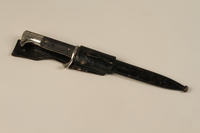
Dagger embossed with a motto and Reichsadler with sheath acquired by a US soldier from German troops
Object
Embossed fighting knife and sheath retrieved by Robert Alden, an American soldier, from German soldiers as he helped to liberate concentration camps in Germany in April-May 1945. The 22 year old Alden was a captain in the Corps of Engineers in the Third Army under General Patton. Divisions of the Third Army liberated several concentration camp, including Dora-Mittelbau, Buchenwald, Dachau and several subcamps. When the war in Europe ended on May 7, 1945, Alden went to the Philippines and was stationed in Japan during the US military occupation.
Nazi Flag acquired by a US soldier from German troops
Object
Nazi flag retrieved by Robert Alden, an American soldier, from German soldiers as he helped to liberate concentration camps in Germany in April-May 1945. The 22 year old Alden was a captain in the Corps of Engineers in the Third Army under General Patton. Divisions of the Third Army liberated several concentration camp, including Dora-Mittelbau, Buchenwald, Dachau and several subcamps. When the war in Europe ended on May 7, 1945, Alden went to the Philippines and was stationed in Japan during the US military occupation.

